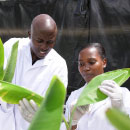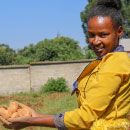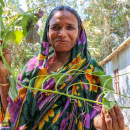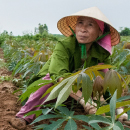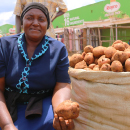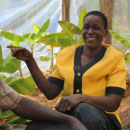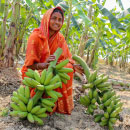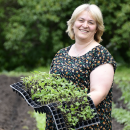Triple S stands for Storing in Sand and Sprouting, a new technology that gives farmers better access to good quality sweetpotato seed when they most need it.
As the name suggests, it involves farmers storing selected sweetpotato roots in sand through the dry season, planting them out in an irrigated plot six to eight weeks before the start of the rainy season. The method is more consistent than the traditional practices of leaving some roots in the ground after harvest, eventually to sprout. It is especially valuable for orange fleshed sweetpotatoes (OFSP), which are less tolerant to drought and may not survive the dry season unaided.
Farmers who have been trained to use the Triple S technology package are very enthusiastic, not only for their own farms but also because they supply neighbors and even distant traders with vines, earning a bit more cash.
Spreading the use of Triple S is part of many RTB projects to scale up the use of OFSP in Africa, using a variety of channels to disseminate the information. One Triple S scaling project used face-to-face training, radio and video in various combinations, which raises the question of how women and men perceive the different channels and whether access to information is affected by gender. To find out, RTB researchers used sex-disaggregated focus group discussions with farmers in southern Ethiopia and northern Ghana.

Face to face contact was the preferred channel for women and men. Not only did it allow them to learn by doing, it also offered the opportunity to seek clarity by asking questions. Face to face was especially important for women because the meetings are valuable social networking events and allow women to mentor and encourage one another. Then again, although meetings may be the best channel to reach women, there may be social norms that prevent them from attending.
Men appreciated video and radio, and seeing the personal testimonies of other farmers in videos was a powerful incentive to adopt Triple S technology. Women, however, did not like radio and video presentations. One factor was the inability to ask clarifying questions; women’s generally lower literacy meant that they could not rely on taking notes to supplement the experience. More importantly, perhaps, women simply don’t have access to radios or batteries. They rely on their husbands to listen to the radio. Even when they can listen, broadcasts are often at an unsuitable time, for example in the evening when women are preparing food. Community radios, with broadcasts at better times, could help, as could repeat broadcasts.
This research shows how important it is to understand the gender norms and practical needs of women and men when designing communication channels to disseminate new technologies and promote uptake. Differences between men and women, for example in access to radios and literacy, can affect how much use they can make of the information that is offered. The cost savings and scalability of audio and video, especially in conjunction with on-demand delivery through smartphones, make them tempting alternatives to face to face engagement. Such use of information and communication technologies may well be the future of technology training. However, any effort to make greater use of audio and video, especially through phones, will have to ensure that women are able to use those technologies, so that they can benefit from improved seed system technologies.

